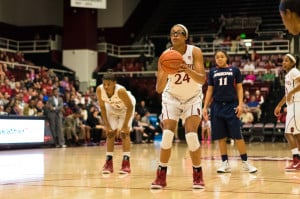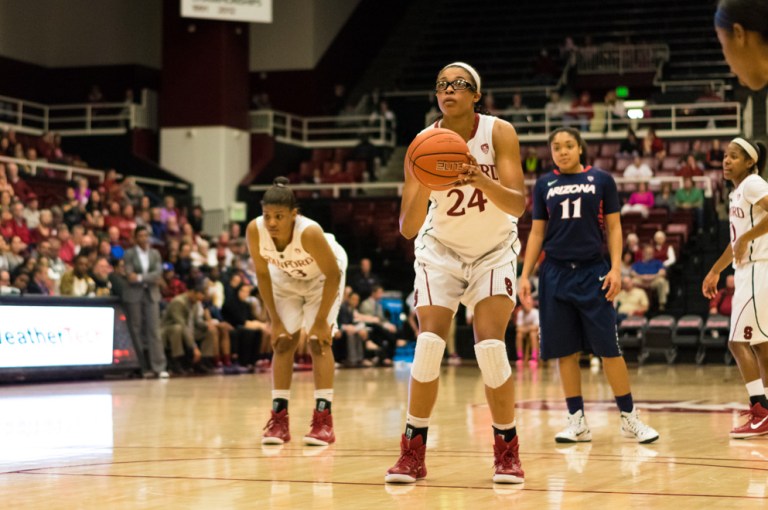The No. 11 Stanford women’s basketball team (13-5, 5-1 Pac-12) will look to rebound after Monday’s tough loss against ASU when it travels this weekend to Southern California to take on UCLA and USC.
After several close conference games, including two come-from-behind wins, the Cardinal finally dropped their first Pac-12 game of the season, marking the first time since 1984 that Stanford has lost to the Sun Devils at Maples Pavilion.
Yet the series against the Arizona schools started on a high note after Stanford defeated Arizona, 77-47, led by a quintet of players scoring in double figures. Both Samuelson sisters combined for eight threes and 26 points, while sophomore forward Erica McCall recorded her first career double-double with 13 points and 16 rebounds. For the second game in a row, sophomore guard Briana Roberson scored in double digits, while sophomore guard Lili Thompson, who leads the team with 15.2 points per game, contributed 12.

Monday’s matchup, on the other hand, bore little resemblance to Friday’s game. At halftime, Stanford found itself down by 17 after ASU came out playing aggressive defense, while the Cardinal gave up 39 points and got outrebounded 24-10. As it had done in recent games, Stanford put together an impressive comeback, a 24-8 run initiated by improved shooting and intense defense, that put Stanford within one with five minutes left in the game. However, the Sun Devils responded by going on a 10-4 run that Stanford fought to diminish but ultimately could not overcome.
“You have to play 40 minutes. 20 minutes won’t get it done,” said head coach Tara VanDerveer about her team’s inconsistent performance.
VanDerveer also saw that the squad did not have the proper mindset going into the game.
“A team [ASU] comes in here and they haven’t won in 30 years. They’re hungry and I thought we started the game kind of nonchalant, and you can’t do that,” she added. “You have to come out and be very aggressive and hungry.”
Such a change in mindset is something the Card recognize as necessary and will look to implement for the rest of the season.
“I think everybody’s just motivated,” said senior guard Amber Orrange. “The second half [of the ASU game] we showed that if we play with intensity and play with the grit we played with, we can compete with anyone, so we want to play like that moving forward; we’re going to focus on that.”
***
Following the Card’s poor defensive performance during the first half of Monday’s game, the team must diminish the impact of the UCLA Bruins’ best players, most notably junior guard Nirra Fields (14.3 points per game), redshirt sophomore guard Kari Korver (11.2) and freshman guard Jordin Canada (10.6). Despite its losing record (8-9), UCLA has performed well in Pac-12 play: Its 4-2 record includes close wins against Utah and Colorado, teams Stanford beat by 11 and seven, respectively, and solid victories against USC.
Unlike UCLA, USC’s (11-6, 3-3) best offensive and defensive threat is found in the paint: senior forward Alexyz Vaioletama leads her team in points per game (13.1), rebounds per game (6.9) and total blocks. The Card allowed ASU to score 20 points in the paint in the first half alone, revealing a weakness upon which Vaioletama may try to capitalize. To prevent a similar issue from occurring, Stanford’s posts will have to step up and prevent Vaioletama from getting good looks at the basket.
USC’s perimeter threats include freshman McKenzie Calvert (11.9 points per game) and junior Brianna Barrett (10.4 ppg).
In Stanford’s best games, multiple players contribute in various ways: not only by hitting jumpers, but also by playing shutdown defense, getting steals, making free throws and rebounding. The Arizona game reflected what Stanford can do at its best: score on threes and in the paint, play solid defense, rebound and not have to rely on its star players, Thompson and Orrange, to do the bulk of the scoring. The team showed flashes of this type of play during the second half of the Arizona State game, particularly with contributions from McCall, Roberson, Greenfield and Orrange, but this level of play needs to be present for the entire game, or at least enough of it so that the Card make a solid first-half appearance and don’t get down by nearly 20 points.
.@aorrange_33 on the @WoodenAward Midseason Top 20. Congrats Bam! http://t.co/C6ebZHAyqZ #GoStanford pic.twitter.com/3GJI8PaCbO
— Stanford WBB (@StanfordWBB) January 21, 2015
One key to Stanford’s success is getting one or both of the Samuelson sisters shooting threes. To do so, guards can drive into the paint and dish out to the sisters, who should benefit from the open shooting lanes.
If Roberson and McCall continue to play how they have been playing, the Card will be able to have a multi-dimensional system of attack. Roberson has been hitting inside shots off the drive, while at her best, McCall scores from the block and tallies some rebounds and blocks.
“Bri gives us a lot of energy,” VanDerveer said. “She has great speed, she works really hard defensively, her numbers are really good in terms of her offense, her free throws are great, and she loves to play.”
“When you’re playing in January or February you got to love to play,” VanDerveer added. “They [Roberson and McCall] come out, they have a lot of energy and they’re excited about playing time.”
The past six games have reflected how physical and competitive the Pac-12 has been and will continue to be throughout the season. Whether they are ASU, Washington State or Colorado, Pac-12 teams consistently come to play and make Stanford work hard to earn a win. As such, these next two games will prove to be key matchups to see not only how Stanford will respond to its recent loss, but also what direction the team is headed for the rest of the season.
“They [UCLA and USC] are both really good teams; they have a lot of balance,” VanDerveer said. “It’s going to be a great matchup and I’m excited to see our team kind of rise to the challenge and be more aggressive and play the way we’re capable of playing. And 40 minutes has got to be our mantra.”
The Cardinal will face UCLA Friday at 7 p.m. and USC Sunday at 5 p.m.
Contact Alexa Phillippou at aphil723 ‘at’ stanford.edu.
